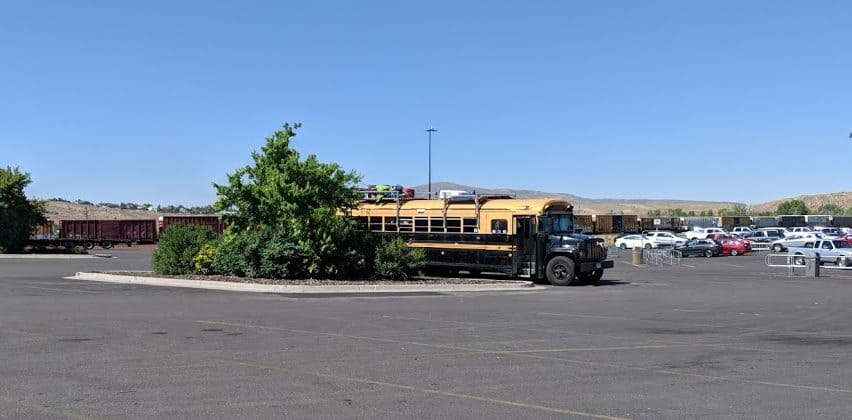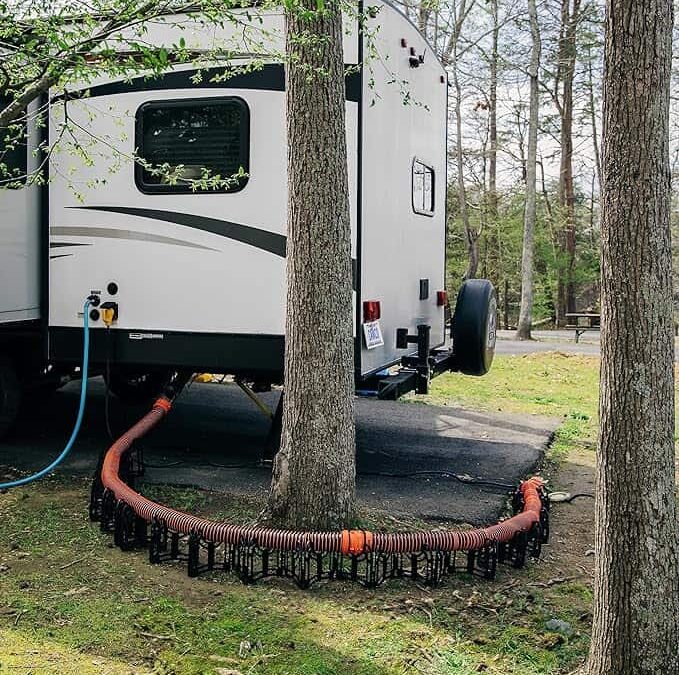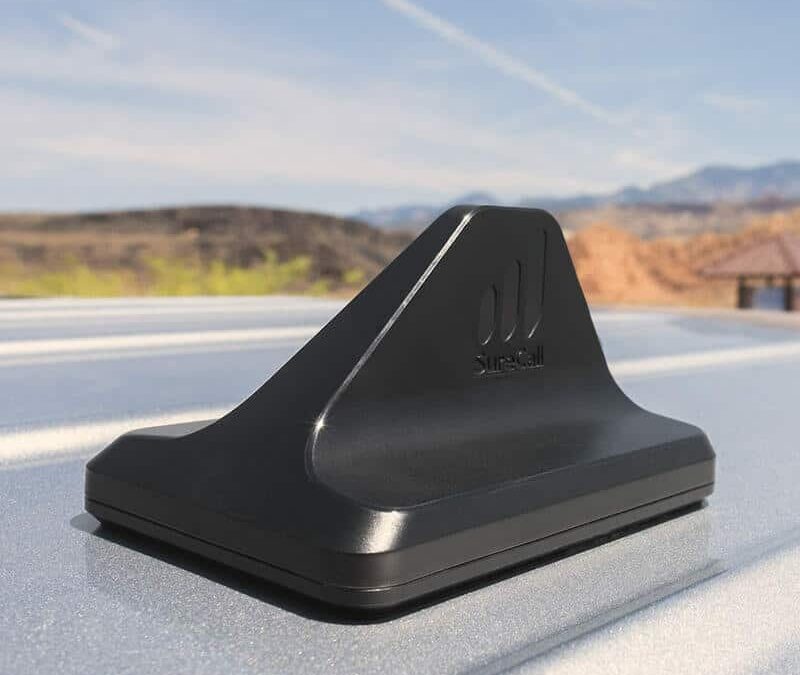Two of the most popular ways to live an alternative lifestyle on the road are van life and skoolie life. Some of the questions we get asked most often come down to the pros and cons of each and which we think is better.
Below we dig into the nitty-gritty details of starting in both lifestyles and give you some of the most significant advantages of each.
Overview of Van Life and Skoolie Life
Van and skoolie life are alternative ways of living in a mobile setting that allows you to cut costs and travel. Vandwellers convert passenger, cargo, or other types of vans into a snug yet comfortable living space with life essentials.
Skoolie folks follow a similar train of thought, just with school and other buses as the base. Both van life and skoolie life make it possible to travel and experience life on the road, but there are several key differences that you should think of before you make your choice.
Living Space
The most glaring difference between living in a van and living in a skoolie is the amount of space. It and cost are the two most important considerations when making your choice.
Van Living Space
Van’s are bigger than your average car but still not very large compared to the average home. Within types of vans, you’ll have a lot of variabilities.
Your basic cargo or conversion van offers around 40-50 sq ft of usable space but probably won’t have the height to let you stand up in it. A Sprinter boasts more than 90 sq ft of usable living space and allows you to stand upright as long as you aren’t a giant.
That’s pretty close to the minimum amount of space we’d recommend for 1-2 people to live in. It gives you enough room for a full-size bed and essential storage but won’t allow much activity inside.
Skoolie Living Space
Skoolie’s are mostly built from used school buses and offer significantly more space than a van. Even a short bus with a 25-foot length gives you 150-200 sq ft of workable space, and a full-size bus rivals an apartment.
School buses universally have enough headroom for you to comfortably walk upright in and offer plenty of flat, usable space to build out a home. You’ll have no problem subdividing a skoolie to build things like a bathroom, bedroom, kitchen, and even a shower if you want to go crazy with it.
Purchase Cost
Vans start cheaper than skoolies at the lower end of the market but can quickly rise in price. Generally, a van will be more affordable than a skoolie, but you’re getting less space. As with buying any vehicle, you tend to get what you pay for in terms of reliability and upkeep costs.
Prices below reflect buying used, as very few people purchase new vans or school buses for van or skoolie life.
Van Purchase Cost
Vans start at around $4,000-$5,000 for a high-mileage cargo van and go up as high as $30,000+ for a used Sprinter. At the entry-level point, you’re looking at mileage north of 150,000 and will likely have significant maintenance and repair costs.
If you want a Sprinter, the minimum you should expect to pay is around $15,000, and that $15,000 Sprinter is going to need a lot of TLC. A good rule of thumb is to spend approximately $8,000-$10,000 on a cargo van and about $20,000-$25,000 on a Sprinter.
That gets you mileage around 100,000 and a better likelihood of avoiding significant mechanical problems.
Skoolie Purchase Cost
Skoolies, like a lot of things, have shot up in price over the last few years. Where you could once pick up a decent condition (sub-150,000 mileage and rust-free) bus for $5,000-$10,000, we doubt you could find one on blocks for that today.
A 30-45 ft bus with 150,000 miles or less on it is going to run at least $15,000, with $20,000 more likely what you’ll pay. That puts a skoolie price competitive with a Sprinter but noticeably more expensive than a cargo van.
Cost to Convert
Buying your new home is just the first step. There are significant differences between converting a van and converting a skoolie. We assumed a base level of conversion, including:
- Bed/Furniture
- Storage
- Electrical systems
- Plumbing/Sink
- Vent Fan
- Insulation
- Flooring
- Walls
- Ceiling
You can do it without some or even all of these, but for a permanent van/skoolie life conversion, these are what we consider the norm. The prices below are for DIY conversions, as professional conversions for van life or skoolie life are significantly higher.
Van Cost to Convert
Brass tacks, you should expect to spend a minimum of $5,000 converting a van into a van home. That gets you a basic bed platform with a mattress, minimum electrical system, a vent, insulation, walls, floors, and some kind of cook system while assuming you’ve already got most of the tools you’ll need available.
If you want a more ‘Insta’ van with higher-end materials, a permanent stove/oven, and a more powerful solar system with a larger battery bank plus appliances, you’re looking at closer to $15,000 or even $20,000.
With the cost of your van, you’re looking at around $15,000 to $35,000 as a realistic starting cost range.
Skoolie Cost to Convert
Skoolie’s are bigger than vans and give you a lot more usable living space, but that has its downsides in terms of cost. The minimum price for a skoolie build is around $10,000, though again, that’s bare-bones and without any added comforts.
For those picturing the ‘apartment on 6-wheels’ skoolie life, you should budget a minimum of $20,000 and more realistically $30,000-$35,000.
With the cost of the bus, you’re looking at around $45,000 to $60,000 as a realistic total starting cost range.
That may seem like a lot, but with the average U.S. home prices hitting $374,900 in 2021 you’re still living very comfortably at a fraction of the cost.
Van Life Advantages
Vans offer significant advantages for those looking to travel widely and for as low a cost as possible.
Vans Get Better Fuel Economy
Vans are smaller, lighter, and have more fuel-efficient engines than skoolies. A diesel Sprinter gives you up to 21 mpg while your average cargo van tops out at about 15-16 mpg.
That doesn’t sound that great when looking at modern cars’ wunderkind mpg numbers, but compare it to the 6-10 mpg you’ll get from a 10+-year-old skoolie. For most skoolie folks, you can expect about eight mpg from a 30+ ft bus, making it double or triple as expensive to drive a skoolie the same distance you drive a van.
Vans Can Go Almost Anywhere
If you’re the kind of person who longs to drive until the road runs out, then drive some more, a van is the way to go. Base model vans won’t be off-roading, but they hold their own just fine on dirt tracks and can get you to some pretty incredibly remote places.
If you want to really get off the beaten track, you can pick up a 4WD van and visit just about anywhere. Skoolies, by comparison, are creatures of the blacktop and the very best maintained gravel and dirt roads.
For those looking to go deep into the backcountry and experience the world’s wild places, a van is the way to go.
Vans can Park Anywhere
One of the great things about van life is that you can turn almost anywhere into a place to sleep the night. Stealth camping is a big part of the van life experience and is made possible because of how non-descript your average big white van is.
They’re everywhere, and you can park just about anywhere with a bit of care. We spent many a night in parking lots, rest areas, truck stops, and beautiful free campsites while exploring the wild parts of America.
Vans are also small enough to fit into a vast range of parking spots and even commercial garages if you need to do something in the city. That can come in handy if you want to catch a show or hit up a specialty store.
Skoolies are the opposite of stealthy. They’re very cool, but they attract attention everywhere they go. Try to park a skoolie on a quiet residential street for the evening, and it will be minutes before you get the dreaded knock.
It makes finding safe places to spend the night harder and more expensive, as a lot of the time the best option will be to get a spot at a campground or RV park for the night.
Vans Cost a Lot Less to Repair
Driving older vehicles thousands of miles across the country is going to put some wear and tear on them. Unless you’re a mechanic yourself, repair costs add up fast.
Vans take the win here, given how utterly ubiquitous they are. You can find mechanics with experience working on your van in every podunk town and wide spot of the road pretty much anywhere. They might even have the parts you need in stock because of local demand from contractors.
By comparison, it can be a struggle to find a mechanic with experience working on a school bus. It can be even more of a hassle to find the specific parts needed for your school bus engine.
All of that means that repairs, even major repairs, on a van run less than similar repairs on a skoolie and usually require less downtime waiting for parts and mechanics.
Skoolie Life Advantages
By virtue of their size and interior configuration, skoolies have some advantages that vans just can’t match.
Skoolies are for Families
Let’s face it, skoolies are a lot larger and more practical from a living space standpoint than vans. That’s especially true if you’re trying to take your partner and kids along for the ride.
Two is the maximum I would recommend to live in a van. More than that and you start to feel like you’re living on top of each other. A skoolie has space for people to have space. It also has more storage space available for the little things that can make traveling the country and the world more fun and more sustainable.
Skoolies Offer Comforts
That storage I mentioned? It’s really noticeable when it comes to comfort items. In a van everything has to serve multiple purposes, and sometimes that means that things you really love can’t fit into your life.
Skoolies are still small, but they offer a lot more wiggle room for those ‘nice to have’ items that won’t fit into van life.
Skoolies are More Livable
As someone who’s lived in a van I can tell you that it’s not for everyone. It takes a significant adjustment to your lifestyle and mindset to be able to squeeze your entire life into a space not much bigger than many people’s closets.
The smallest skoolie is bigger than the biggest van, and it’s noticeable in livability. Most skoolies feel more like a traditional apartment than do most vans. It makes adjusting to life in a skoolie a lot easier for the average person.
Skoolie’s are big enough for bathrooms, showers, and even rooms that you can shut a door or curtain and get a little privacy.
Final Thoughts
As you can see, there’s no one answer to van life vs. skoolie life. On average, you’ll spend more building out and living in a school bus than you will building out and living in a van. On the other hand, you’ll have a lot more living space in a more convenient layout in a skoolie than in a van.
Picking between the two comes down to your specific needs, how many people will be living with you, and what kind of lifestyle you’re looking for.
If you’re single or traveling with a partner and want to see as much of the wide wild world as you can van life is your best bet.
If you’re traveling with kids and are willing to spend a little more upfront, or if you just want more space to spread out and ‘be’ in, a skoolie is the way to go.




